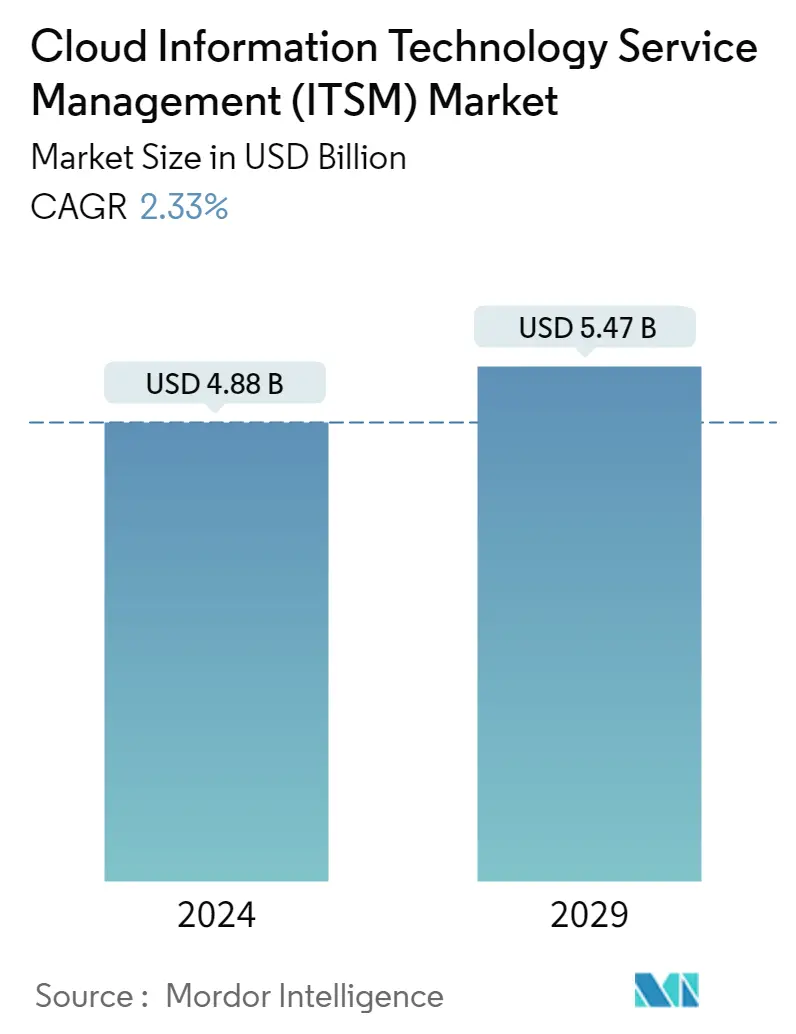Market Size of Cloud Information Technology Service Management (ITSM) Industry

| Study Period | 2019 - 2029 |
| Market Size (2024) | USD 4.88 Billion |
| Market Size (2029) | USD 5.47 Billion |
| CAGR (2024 - 2029) | 2.33 % |
| Fastest Growing Market | Asia Pacific |
| Largest Market | North America |
Major Players_Market_Major_Players_Logo.webp)
*Disclaimer: Major Players sorted in no particular order |
Need a report that reflects how COVID-19 has impacted this market and its growth?
Cloud Information Technology Service Management (ITSM) Market Analysis
The Cloud Information Technology Service Management Market size is estimated at USD 4.88 billion in 2024, and is expected to reach USD 5.47 billion by 2029, growing at a CAGR of 2.33% during the forecast period (2024-2029).
The emergence of cloud computing has significantly impacted the way businesses are being operated. The increasing adoption rate of cloud solutions has brought changes in the operating models by reducing IT infrastructure cost. The deployment of cloud solutions enables enterprises to focus on core business competencies.
- The broad availability of cloud services to support various generalized and specialized business applications is fuelling companies' transformations into digital enterprises. When utilizing cloud services, the service provider's Information Technology Service Management (ITSM) processes become an extension of an organization creating an essential process dependency that must be carefully integrated and managed to avoid introducing time delays, unnecessary complexity, security vulnerabilities, and risk to the company's IT operation.
- The growing usage of cloud-based applications among startups and small and medium-sized businesses drives the cloud IT service management industry. Cloud-based apps help firms reduce IT infrastructure running expenses and increase scalability, collaboration efficiency, work process flexibility, company stability, and other benefits.
- Integration of cloud ITMS solutions and services with advanced artificial intelligence (AI) platforms is one of the developing cloud IT service management (ITSM) industry trends. The AI platform enables enterprises to automate a wide range of IT and enterprise management services while also providing a scalable cloud platform.
- Although the fact that cloud ITMS provides several benefits, the majority of end users are unaware of its availability. Moreover, security concerns for personal data and corporate operations in developing countries where cyber-attacks are on the increase are projected to hinder market expansion.
- The COVID-19 pandemic had a beneficial impact on the market, owing to the rise in remote working and the expanding digital transformation of enterprises. Businesses are looking for business processes that are seamless, efficient, and accessible from any location. Further, many businesses completed their digital transformation, and some have decided to remain fully remote or operate on a digital and in-office hybrid model. Thus, IT teams can expect a sharp rise in the need for internal IT support and cloud ITSM, thereby boosting the studied market growth.
- Overall, the pandemic has fueled the cloud ITSM market, and the market is also expected to witness prolific growth post-pandemic, with most organizations shifting to a hybrid workplace model. The enhancing support and services from deploying the cloud ITSM tool would also remain a significant factor in boosting the studied market post-pandemic.
